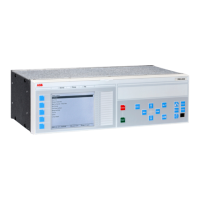9.2.7.2 Delta current and delta voltage detection
A simplified diagram for the functionality is found in figure 91. The calculation of the
change is based on vector change which means that it detects both amplitude and
phase angle changes. The calculated delta quantities are compared with their
respective set values DI< and DU> and the algorithm, detects a fuse failure if a
sufficient change in voltage without a sufficient change in current is detected in each
phase separately. The following quantities are calculated in all three phases:
• The change in voltage DU
• The change in current DI
The internal FuseFailDetDUDI signal is activated if the following conditions are
fulfilled for a phase:
• The magnitude of the phase-earth voltage has been above UPh> for more than 1.5
cycle
• The magnitude of DU is higher than the setting DU>
• The magnitude of DI is below the setting DI>
and at least one of the following conditions are fulfilled:
• The magnitude of the phase current in the same phase is higher than the setting
IPh>
• The circuit breaker is closed (CBCLOSED = True)
The first criterion means that detection of failure in one phase together with a current
in the same phase greater than 50P will set the output. The measured phase current is
used to reduce the risk of false fuse failure detection. If the current on the protected line
is low, a voltage drop in the system (not caused by fuse failure) is not necessarily
followed by current change and a false fuse failure might occur.
The second criterion requires that the delta condition shall be fulfilled in any phase
while the circuit breaker is closed. A fault occurs with an open circuit breaker at one
end and closed at the other end, could lead to wrong start of the fuse failure function
at the end with the open breaker. If this is considered to be a disadvantage, connect the
CBCLOSED input to FALSE. In this way only the first criterion can activate the delta
function.
1MRK 511 287-UEN A Section 9
Secondary system supervision
199
Technical manual

